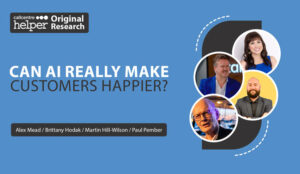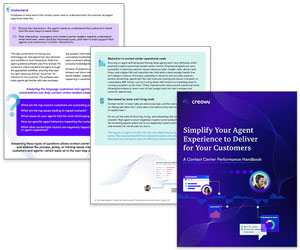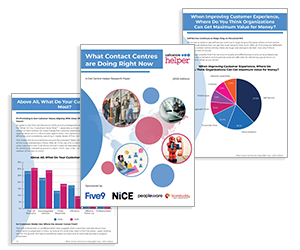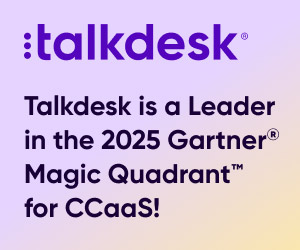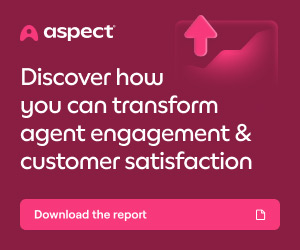AI is quickly becoming a central enabler of exceptional customer experiences – promising to deliver precisely what customers have always valued most: fast resolution, knowledgeable agents, and effortless experiences.
But what’s really happening out there right now?
We’ve put the spotlight on our latest research around customer priorities and AI adoption in contact centres – alongside expert commentary from Alex Mead, Brittany Hodak, Martin Hill-Wilson, and Paul Pember – to find out if AI really is the “silver bullet” to achieving customer happiness.
What Customers Really Value
Our 2025 Report: What Contact Centres Are Doing Right Now shows that First Call Resolution (FCR) and knowledgeable agents remain the top customer priorities, accounting for 30% and 29% respectively.
These metrics aren’t new, but what is striking is how they align with AI’s growing capabilities. For example, AI-driven tools can now help even newer agents deliver high-quality answers consistently.
And real-time agent prompts, intelligent knowledge graphs, and generative AI can guide agents through complex queries, ensuring customers receive the information they need – quickly and accurately.
This perspective is reinforced by shifts in AI adoption across contact centres. Professionals are pinning their hopes on automating responses via chatbots, providing real-time agent assistance, and supporting 24/7 self-service.
The common thread? Customers increasingly expect immediacy and effortlessness, regardless of whether a human or AI is on the other end.
As Martin Hill-Wilson of Brainfood Consulting comments:
“Do customers really care where the answer comes from? Not as much as we think – as long as it’s right. Why? Digital lifestyles have reset expectations around immediacy and effortlessness, and so always-on service and instant answers are now the norm.”
If Journeys Are Broken, AI Simply Frustrates Customers Faster
What’s also interesting here is that when contact centre leaders were asked about the biggest drivers for implementing AI, their top response was Contact Reduction (35%).
However, reducing contacts for the sake of it is a shortcut – not a strategy, as Alex Mead, Global Customer Service Experience Leader, warns:
“If journeys are broken, AI simply frustrates customers faster. The real question is: how do we prevent failure demand by fixing experiences in the first place?”
AI’s true potential therefore doesn’t lie in reducing call volumes, as Mead continues:
“Customer satisfaction isn’t about vague happiness; it’s about experiences that are easy, personalized, intuitive and contextual – what I call EPIC Sales & Service. AI has the power to deliver this when designed around real customer needs, not just business volumes.”
In other words, the goal should be better experiences first, with efficiency as a natural by-product – not the primary driver.
AI-Powered Customer Listening Makes It Far Easier for Organizations to Make the Changes That Really Shift the Dial
Beyond this, AI can also power up an organization’s ability to listen to its customers, and many are embracing this – as our research shows, traditional survey channels are beginning to lose their dominance, whilst AI-powered analytics and VoE programmes rise:
- Email surveys decreased from 59.3% → 55.2%
- Website surveys decreased from 18.6% → 13.6%
- Speech/text analytics increased from 12.1% → 25%
- VoE increased from 50% → 54.3%
Paul Pember, Founder and Chief Consultant at CX Score, comments:
“AI is going to transform how customer insights are captured and used. Despite being used by only 25% of organizations today, I expect speech/text analytics to overtake email and transactional surveys within the next three years, driven by natural language processing that can extract meaning from vast, unstructured datasets.”
The rise of continuous analytics allows contact centres to identify friction points, failure demand, and improvement opportunities in real time – ensuring that AI investments are directly tied to customer satisfaction outcomes, not just operational efficiency.
And the more you can listen to and react to customer needs? The happier they’ll be! As Brittany Hodak, Keynote Speaker and Author of Creating Superfans, adds:
“Your customers are telling you exactly how to win their loyalty. The smartest companies treat that feedback like gold and move quickly to turn it into better experiences.
Companies that embed feedback into their culture create the kind of loyalty and emotional connection that turns everyday customers into passionate superfans.”
Therefore, by combining AI with active feedback loops, contact centres can not only measure satisfaction but design experiences that continuously improve customer happiness.
Success Depends on Intentional Design and Human-Centred Integration
However, AI adoption is only part of the story. Success depends on intentional design and human-centred integration. By focusing on customer satisfaction first, organizations can unlock revenue growth, retention, and advocacy.
As Mead points out:
“Operating efficiently will always matter, but it should be the outcome of fixing experiences, not the main goal. When customer journeys are seamless, efficiency follows naturally.”
AI Must Be Implemented Thoughtfully to Bridge the Gap Between Customer Expectations and Real-World Delivery
Taking all of this into consideration, it’s clear that AI is no longer a futuristic promise. Rather, it’s the tool that bridges the gap between customer expectations and real-world delivery – when implemented thoughtfully.
This ultimately means that for contact centres willing to design with purpose, AI can turn the age-old goal of excellent service into a tangible, measurable reality that truly drives customer happiness. And who wouldn’t want that?
Author: Megan Jones
Reviewed by: Xander Freeman
Published On: 26th Nov 2025 - Last modified: 27th Nov 2025
Read more about - Contact Centre Research, Alex Mead, Artificial Intelligence (AI), Brittany Hodak, Customer Experience (CX), Customer Service, Emotion, Five9, Martin Hill-Wilson, NiCE, NiCE CXone, Paul Pember, Peopleware, Research, Scorebuddy, Top Story





